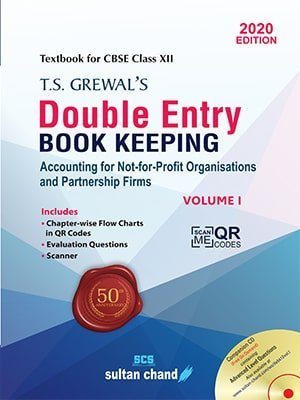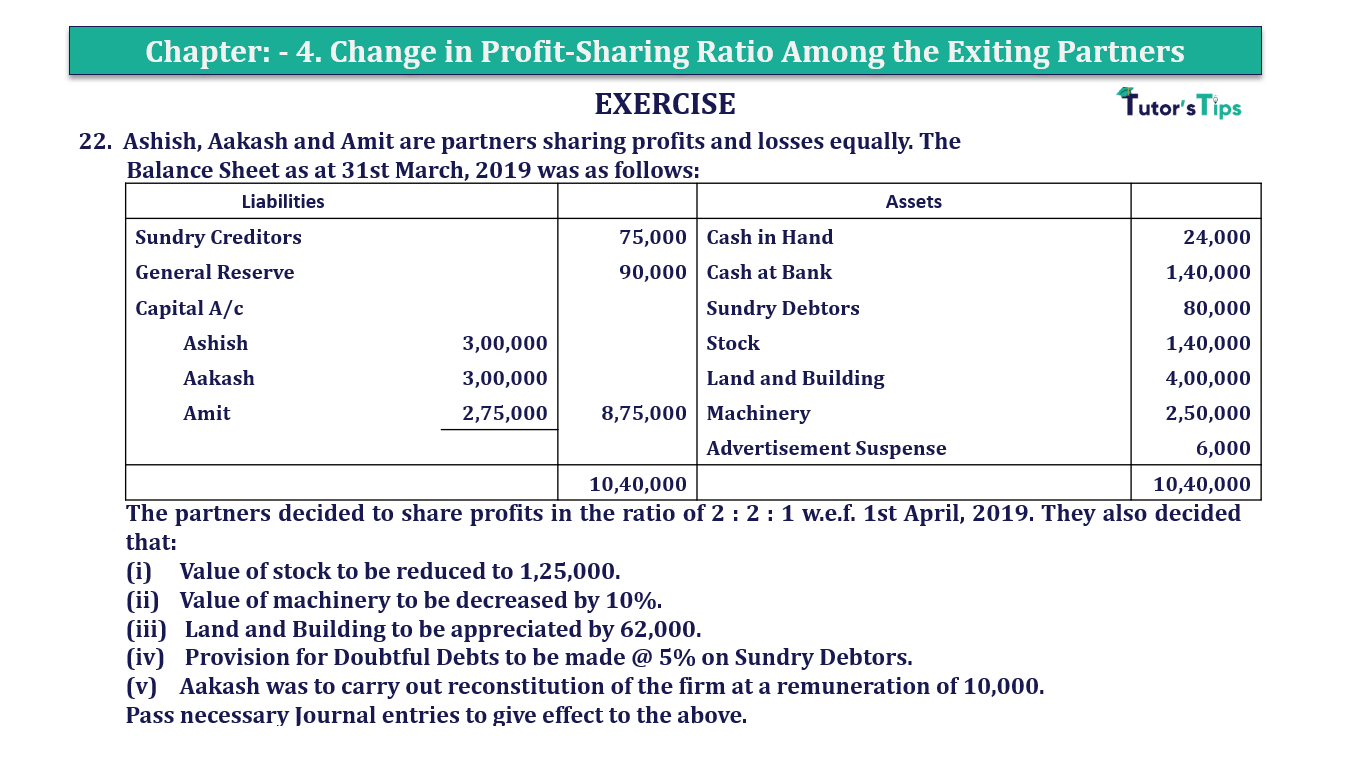Question 36 Chapter 7 of +2-A
36. Following is the Balance Sheet of Vishnu, Sanjiv and Sudhir as at 31st March 2018:
| Liabilities | Amount | Assets | Amount | ||
| Bills Payable | 20,000 | Cash | 8,000 | ||
| Creditors | 18,000 | Bills Receivable | 12,000 | ||
| Mrs. Vishnu’s Loan | 20,000 | Stock | 25,000 | ||
| Outstanding Salary | 5,000 | Sundry Debtors | 40,000 | ||
| Profit and Loss A/c | 10,000 | Less: Provision for D. Debts | 4,000 | 36,000 | |
| Workmen Compensation Reserve | 15,000 | Land and Building | 50,000 | ||
| Capital A/cs: | Furniture | 10,000 | |||
| Vishnu | 40,000 | Computers | 5,000 | ||
| Sanjiv | 30,000 | Investments | 30,000 | ||
| Sudhir | 18,000 | 88,000 | |||
| 1,76,000 | 1,76,000 |
The profit-sharing ratio of the partners is 5 : 3: 2. At the above date, the partners decided to dissolve the firm. The assets were realised as follows: Bill Receivable was realised at a discount of 5%. All Debtors were good. The stock realised 22,000. Land and Building realised 40% higher than the book value. Furniture was sold for 8,000 by auction and auctioneer’s commission amounted to 500. Computers were taken by Vishnu for ana greed valuation of 3,000. Investments were sold in the open market at a price of 45,000, for which commission of 600 was paid to the broker. Bills Payable were paid at the full amount. Creditors, however, agreed to accept 10% less. All other liabilities were paid off at their book value. The firm retrenched its employees three months before the dissolution of the firm and firm had to pay 20,000 as compensation. Prepare Realisation Account, Partners’ Capital Accounts and Cash Account.
The solution of Question 36 Chapter 7 of +2-A: –
| Realization Account |
|||||
| Particular |
Amount | Particular | Amount | ||
| Bills Receivable | 12,000 | Provision for Doubtful Debts | 4,000 | ||
| Stock | 25,000 | Bills Payable | 20,000 | ||
| Sundry Debtors | 40,000 | Creditors | 18,000 | ||
| Land & Building | 50,000 | Mrs Vishnu’s Loan | 20,000 | ||
| Furniture | 10,000 | Outstanding Salary | 5,000 | ||
| Computers | 5,000 | ||||
| Investments | 30,000 | ||||
| Cash A/c | |||||
| Bills Receivable | 11,400 | ||||
| Cash A/c | Debtors | 40,000 | |||
| Bills Payable | 20,000 | Stock | 22,000 | ||
| Creditors | 16,200 | Land & Building | 70,000 | ||
| Mrs Vishnu’s Loan | 20,000 | Furniture | 7,500 | ||
| Outstanding Salary | 5,000 | 61,200 | Investments | 44,400 | 1,95,300 |
| Cash A/c | 20,000 | Vishnu’s Capital A/c | 3,000 | ||
| C’s Capital: | |||||
| Shares of X Ltd. | 1,500 | ||||
| Shares of Y Ltd | 1,000 | 2,500 | |||
| Realisation Profit | |||||
| Vishnu’s Capital A/c | 6,050 | ||||
| Sanjiv’s Capital A/c | 3,630 | ||||
| Sudhir’s Capital A/c | 2,420 | 12,100 | |||
| 2,65,300 | 2,65,300 | ||||
| Partners’ Capital Account |
|||||||
| Part. | Vishnu | Sanjiv | Sudhir |
Part. |
Vishnu | Sanjiv | Sudhir |
| To Realization A/c | 3,000 | – | – | By Balance B/d | 40,000 | 30,000 | 18,000 |
| By P&L A/c | 5,000 | 3,000 | 2,000 | ||||
| By WCL A/c | 7,500 | 4,500 | 3,000 | ||||
| By Realization A/c | 6,050 | 3,630 | 2,420 | ||||
| To Cash A/c | 55,580 | 41,130 | 25,420 | ||||
| 58,550 | 41,130 | 25,420 | 58,550 | 41,130 | 25,420 | ||
| Bank Account |
|||||
| Particular |
Amount | Particular | Amount | ||
| Balance b/d | 8,000 | Realization A/c | 81,200 | ||
| Realization A/c | 1,95,300 | Vishnu’s Capital A/c | 55,550 | ||
| Sanjiv’s Capital A/c | 41,130 | ||||
| Sudhir’s Capital A/c | 25,420 | ||||
| 2,03,300 | 2,03,300 | ||||
Advertisement-X
T.S. Grewal’s Double Entry Book Keeping +2 (Vol. I: Accounting for Not-for-Profit Organizations and Partnership Firms)
- Chapter No. 1 – Financial Statement of Not-For-Profit Organisations
- Chapter No. 2 – Accounting for Partnership Firms – Fundamentals
- Chapter No. 3 – Goodwill: Nature and Valuation
- Chapter No. 4 – Change in Profit-Sharing Ratio Among the Existing Partners
- Chapter No. 5 – Admission of a Partner
- Chapter No. 6 – Retirement/Death of a Partner
- Chapter No. 7 – Dissolution of a Partnership Firm
T.S. Grewal’s Double Entry Book Keeping (Vol. II: Accounting for Companies)
- Chapter No. 8 – Company Accounts – Accounting for Share Capital
- Chapter No. 9 – Company Accounts – Issue of Debentures
- Chapter No. 10 – Redemption of Debentures
T.S. Grewal’s Double Entry Book Keeping (Vol. II: Accounting for Companies)
- Chapter No. 1 – Financial Statements of a Company
- Chapter No. 2 – Financial Statement Analysis
- Chapter No. 3 – Tools of Financial Statement Analysis – Comparative Statements and Common- Size Statements
- Chapter No. 4 – Accounting Ratios
- Chapter No. 5 – Cash Flow Statement
Check out T.S. Grewal +2 Book 2020@ Official Website of Sultan Chand Publication








Leave a Reply